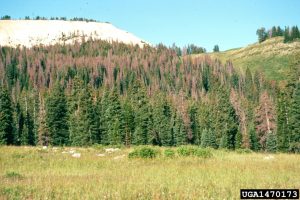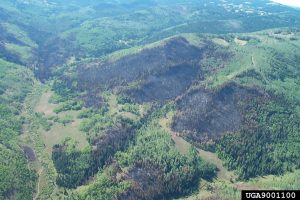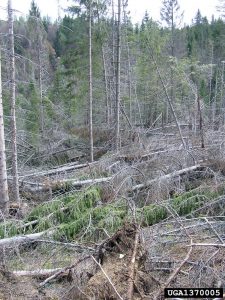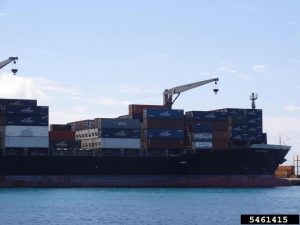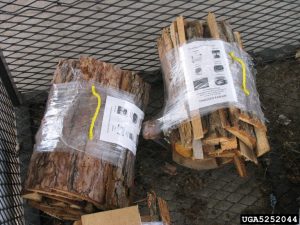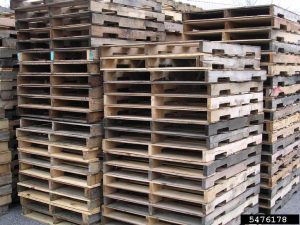Learning Objectives
- To understand what tree and forest health is and why forest health is important.
- To understand what an invasive species is.
- To become familiar with the spread and impacts of invasive species.
- To learn how to collect specimens and report potential invasive species.
- To become familiar with the vocabulary of forest health and invasive species.
What is forest health and why is it important?
The health of forests and trees is important for many reasons and can mean many things to different people in different situations. The most widely used definitions of forest health tend to incorporate two aspects:
- The forest’s ability to sustain unique species composition and processes, and
- The forest’s ability to accommodate present and future needs for a variety of values, products, and services.
Included within those aspects is the forest’s ability to renew itself and be resilient against disturbances.
All forests experience disturbances. Disturbances are any activity that disrupts forests; injures, weakens, or kills trees; or changes the structure or composition of the ecosystem. Disturbances are natural and necessary in forests. Disturbances allow forests to renew, return nutrients to the soil, and can provide important habitat for wildlife. Types of disturbance can include:
- insect activity,
- disease-causing pathogens,
- fire,
- weather or climate events,
- animal activity, and
- human activity, among others.
While some disturbance is natural and part of a healthy forest, too much disturbance or changes in frequency, timing, or severity of disturbances can have negative impacts on our views of healthy trees and healthy forests.
In Alaskan forests, insect outbreaks, pathogens, wind events, and fires are common disturbance types. These disturbances can be normal and healthy in the forests; however, large-scale events such as the spruce beetle outbreak of the 1990’s on the Kenai Peninsula and the Copper River Valley, can be devastating.
- Spruce mortality as a result of spruce bark beetle infestation. Photo by A. Steven Munson, USDA Forest Service, Bugwood.org
- A fire damaged forest. Photo by Doug Page, USFS/BLM, Bugwood.org
- Downed trees after a wind storm. Milan Zubrik, Forest Research Institute-Slovakia, Bugwood.org
Invasive species are also disturbance agents in our forests and urban trees and can be devastating for forest health since invasive species pose challenges that native pests do not.
What is an invasive species?
An invasive species is a species that is not native to the ecosystem and whose introduction causes or is likely to cause economic or environmental harm or harm to human, animal, or plant health (Executive Order No. 13112, 1999).
Several factors contribute to invasive species’ success in establishing and spreading in new environments. These factors include:
- Being adapted to the climate in the new region. Species that may come from similar climates may not suffer mortality during extreme conditions. Other species may be able to tolerate a wide variety of conditions that allow them to survive in the new location.
- Being a generalist, in general. Not being too picky about where you live or what you eat can improve a species chance of establishment and survival in a new location.
- Having a high rate of reproduction. Species that can reproduce quickly and make lots of offspring can usually establish and spread more easily.
- Having a high rate of dispersal. Species that can quickly move to new locations can be more difficult to manage stop before they spread.
- Lacking natural enemies. A species in a new area often shows up without the predators and parasites that help to keep populations low in its native range. In the new range, it may take time for native predator and parasite populations to catch up or find the new pest in the first place.
- Lacking host resistance in the new range. Depending on the pest, a host may have some natural defenses against it in its native range. Often the species used as hosts in the new range lack defenses against the pest.
- Having few competitors or outcompeting competitors in the new range. A species’ ability to outcompete native species or to occupy a part of the ecosystem that does not have many competitors to begin with increases its likelihood of survival and establishment.
Once a species establishes in an area, there are several impacts it may have on the environment, economy, or human health. Invasive species can:
- Outcompete native species. Invasive species may be able to more quickly utilize resources than native species and therefore “push” them out of an area.
- Reduce habitat for native species. Some invasive species make an area no longer suitable for native species, whether it is plants that might produce a chemical limiting other plants’ ability to grow or an invasive insect that kills the host plant of a native insect.
- Alter forest health and productivity. Invasive forest pests can change the way a forest functions, decreasing forest health and limiting productivity of the forest for a wide range of uses. In forests where trees may be harvested, invasive species can impact these industries.
- Impact ecosystem processes. Invasive species can alter and disrupt water, nutrient, and energy cycles through their feeding or presence.
- Degrade recreational areas. Aquatic invasive plants may grow so rapidly in a body of water that fishing quality is diminished.
- Facilitate secondary invasions. Occasionally one invasive species may make an area more suitable for another invasive species. An insect pest may kill several trees in an area that make it possible for an invasive plant to establish.
- Result in regulatory controls. Regulatory controls can restrict trade, increase costs due to treatments, or potentially limit access to raw materials because of restrictions on movement.
Invasive species can be transported to new areas in many different ways. Often invasive species are first brought to the country through the shipment of goods. Invasive forest pests can travel to new locations in living plants for the plant trade, wood packaging material including crates and pallets, and as general hitchhikers on a variety of items.
- The cargo, packaging material, and shipping containers on this ship can all harbor potential invasive species. Photo by Joseph LaForest, University of Georgia, Bugwood.org
- Invasive insects can be hidden within firewood and transported to new locations. Photo by Joseph O’Brien, USDA Forest Service, Bugwood.org
- Wood used in pallets, crates, and other packing materials can harbor invasive insects. Photo by USDA Forest Service Southern Research Station, USDA Forest Service, SRS, Bugwood.org
Once established in the country, firewood is a common way that invasive forest pests can be moved to new locations. Firewood can harbor different life stages of pests under the bark or within the wood where they are difficult to detect. Insect eggs can also be present on firewood and go undetected. If unburned firewood is left in a new location, the pests may have the opportunity to complete their lifecycle and emerge to infest nearby trees.
Invasive species can also spread naturally. Invasive plants have seed dispersal mechanisms that contribute to natural spread, and pathogens such as fungi can utilize wind and water to spread their spores. Insects are particularly well suited for natural spread since many of them can fly or otherwise crawl to new locations.
We have been moving people and goods for a very long time, why are invasive species so threatening now? Invasive species have always been threatening. We are still dealing with the consequences of several historical invasions in our forests such as European gypsy moth, Dutch elm disease, and chestnut blight. What makes current conditions unique is that we are now able to move more goods more quickly. Meaning the insects, etc. that accompany the goods are more likely to survive the journey than they were in years past.
How do we monitor for and manage invasive species?
PreventionThe primary goal of any invasive species program is to prevent the pest from reaching and establishing in a new area. Prevention is accomplished in several ways:
- border inspections: inspecting goods before they pass between jurisdictions
- best practices: developing and implementing practical best practices for industries that might be involved in a pathway for invasive species introduction (Ex: vegetation mowing protocols for weeds near roadways)
- limiting or encouraging limits on movement of goods/pathways: regulatory statutes such as quarantines that legally limit or prevent the movement of goods into or out of an area or social programs that encourage people to do their part to help prevent the spread of invasive species (Ex: don’t move firewood, don’t move a mussel)
- Detect invaders before they have a chance to establish in a new area and
- Assess and respond to the detection rapidly to prevent spread and minimize the amount of damage done
Most EDRR programs rely on active trapping or scouting for invasive species. Several trapping programs occur throughout Alaska for terrestrial and aquatic invasive species. Forest pests commonly trapped for as a part of EDRR programs include defoliating moths, bark beetles, and wood borers. Trapping programs allow managers to “look” for several invasive species at the same time in various locations throughout the state. For more information about Early Detection and Rapid Response (EDRR) see this writeup.
Citizen scientists can also play an important role as first detectors in the early detection of invasive species. Not all pests can be trapped for in all areas so reports from the public and natural resource professionals are important avenues for early detection of potential invasive species. Several detections of invasive species have been the result of reports from concerned landowners.
Invasive insect pests of trees
We have many species of insects that are native to Alaska and can cause varying degrees of tree damage in our forests. For more information on native and established pests of trees in Alaska see: Insects and Diseases of Alaskan Forests.
The focus of the remaining modules will be on three groups of insect pests of trees. The modules will highlight potential invasive species that are not native or present in Alaska but that have the potential to be damaging if they were to be introduced. These groups are:
Wood boring insects
Wood boring insects bore into the sapwood and sometimes heartwood of trees and shrubs. Wood boring insects usually attack weakened, dead, or dying trees; however, some potential invasive species will attack otherwise healthy trees.

Branch dieback resulting from wood borer activity. Photo by Steven Katovich, USDA Forest Service, Bugwood.org

The galleries under the bark of this birch tree are the result of bronze birch borer activity. Photo by Steven Katovich, USDA Forest Service, Bugwood.org
Bark beetles
Bark beetles live and feed between the bark and the wood of trees and shrubs. This feeding can be very damaging because it disrupts the tree’s ability to feed itself. Additionally, many bark beetles carry fungi that can further compromise a tree’s ability to transport water and nutrients.

Spruce mortality as a result of bark beetle damage. Photo by Edward H. Holsten, USDA Forest Service, Bugwood.org

Galleries created by bark beetle feeding beneath the bark of the tree. Photo by Edward H. Holsten, USDA Forest Service, Bugwood.org
Defoliating moths
The larvae of some moths feed on the leaves or needles of trees to such an extent that it weakens, or in extreme cases, kills the trees. These insects are referred to as defoliating moths.

Alder and willow defoliation in Arctic Valley due to an outbreak of geometrid moths in 2011. Photo by Michael Rasy, University of Alaska Fairbanks-Cooperative Extension Service
Reporting information and submitting specimens
Modules 2, 3, and 4 will go over the groups of potential invasive insects in more detail, including identification information and what signs and symptoms to look for. If you encounter a specimen or suspicious damage, here’s how to collect it and/or report it.
If you observe an insect damaging a tree and cannot identify it as one of our native species, it is best to collect the specimen and submit it for identification.
Insect specimens, while somewhat sturdy, are still fairly fragile and should be treated with care. Live insects should be killed before submitting them. Insects can be killed by placing them in the freezer for a night or two or by drowning them in alcohol (70% rubbing alcohol will work). Insects can then be placed in a tightly sealed, sturdy container and brought or mailed to your local Cooperative Extension office.
Please group specimens by the location/tree from which they were collected. Do not put specimens from different locations in the same container. Please include collection information with each container submitted.
An important aspect of insect specimens that people often forget is the importance of collection information. When you collect a specimen, please make note of the following data:
- Location information – Country, state, location
- Latitude/Longitude – If possible collect this with a GPS unit and include +/- accuracy. If you do not use a GPS unit, a physical address is second best.
- Habitat description, host plant, collection method used (e.g. hand collected, sweep net, trap)
- Date and collector – Abbreviate date with letters not numbers to avoid confusion.
Example:
- USA: Alaska: Anchorage
- 61.205825, -149.88631 +/- 10m
- Ornamental landscape, lilac shrub, hand collected
- 13JUL 2015 M.J. Moan
If you do not find any insects, photos of suspicious damage are also welcome! Photos can be submitted through our Pest Portal or to uaf-foresthealth@alaska.edu.
Digital photos can be great tools for insect identifications. Keep in mind, though, that photos are not without their limitations. The tips below can help improve the likelihood of getting an accurate and quick diagnosis when submitting digital photos.
- Check photos for clarity before submitting
- Submit original, unedited photos
- Include a size reference in your photo (coins and pencils/pens work great if you don’t have a ruler available)
- Include as much information about the subject as possible
- Include the same collection information as if you were submitting a physical specimen
Summary
- Trees and forests are healthy when they can sustain their unique species composition and processes and accommodate a variety of values, products, and services.
- Forest health is important because forests and trees provide many benefits ecologically, environmentally, and economically.
- An invasive species is a species that is not native to an area and causes or is likely to cause harm.
- Invasive species can be spread by the movement of goods and people to new areas.
- Invasive species threaten natural ecosystems by outcompeting native species, feeding on native species, and decreasing biodiversity.
- Insect specimens can be collected and reported to:
- the IPM Pest Portal or
- uaf-foresthealth@alaska.edu
Vocabulary
- Bark beetle: A type of beetle that lives and feeds between the bark and the wood of trees and shrubs
- Defoliating moth: A moth whose larvae feed on the leaves or needles of trees and shrubs
- Disturbance: any activity that disrupts forests; injures, weakens, or kills trees; or changes the structure or composition of the ecosystem
- Ecosystem services: A positive benefit that ecosystems provide, such as drinking water, timber, and erosion control.
- Forest health: the forest’s ability to sustain unique species composition and processes and accommodate present and future needs for a variety of values, products, and services
- Invasive species: a species that is non-native to the ecosystem and whose introduction causes or is likely to cause economic or environmental harm or harm to human, animal, or plant health
- Natural enemy: living organism found in nature that kills or weakens its prey or reduces its reproductive potential
- Niche: the role a species has in its environment
- Non-native/non-indigenous: any organism living outside of captivity or cultivation that did not historically occur in that area
- Pathway: the means and routes by which invasive species are imported or introduced into new environments
- Wood borer: An insect that bores into the sapwood and sometimes heartwood of trees and shrubs
Sources and More Information
- Invasive species. National Wildlife Federation. Last accessed February 8, 2016, from https://www.nwf.org/Wildlife/Threats-to-Wildlife/Invasive-Species.aspx.
- Why are invasive alien species a problem? July 19, 2013. Environment and Climate Change Canada. Last accessed February 8, 2016, from https://www.ec.gc.ca/eee-ias/default.asp?lang=En&n=4612AC81-1.
- Invasive species. February 15, 2011. International Union for Conservation of Nature. Last accessed February 8, 2016, from http://www.iucn.org/about/union/secretariat/offices/iucnmed/iucn_med_programme/species/invasive_species/.
- Frequently Asked Questions. Hungry Pests. Last accessed February 8, 2016, from http://www.hungrypests.com/faqs/.
- Invasive species. April 29, 2015. U.S. Forest servie – Pacific Northwest Research Station. Last accessed February 8, 2016, from http://www.fs.fed.us/pnw/invasives/.
- Committee, I. June 11, 2014. Arctic boreal forest environments. Last accessed February 8, 2016, from http://www.eoearth.org/view/article/150204/.
- Exec. Order No. 13112, 3 C.F.R. 6183 (1999).
